"The idea was to bring together a group of remarkable people to see if they could become something more." – Nick Fury.

The Avengers is a team of superheroes, each with a special skill, who assemble during desperate times and save the world from villains. In the world of sales, a sales pod operates similarly. It's a team of sales professionals who join forces, combining their strengths and expertise to achieve remarkable results. They collaborate, strategize, and support each other to overcome challenges in sales.
Definition and Overview of Sales Pods
Sales pods are a modern approach to sales organization and team collaboration to maximize efficiency and drive better results. In a nutshell, a sales pod is a small, cross-functional team of sales professionals who work together closely to achieve common goals. Unlike traditional sales team structures, where individuals work independently or within larger groups, sales pods are designed to foster collaboration, communication, and collective accountability.
The concept of sales pods draws inspiration from agile methodologies and the recognition that successful sales outcomes often require a coordinated effort. By bringing together individuals with complementary sales skills and expertise, sales pods enable teams to leverage diverse perspectives and tackle complex sales challenges more effectively.
Sales pods typically consist of a small group of sales representatives, supported by other roles such as account executives (AEs), sales development representatives (SDRs), customer success managers (CSMs), and sales operations professionals. The pod members work in close proximity, sharing resources, insights, and responsibilities. They collaborate on various stages of the sales process, from prospecting and lead generation to closing deals and managing relationships with customers.
Read more about account executives and sales development reps.
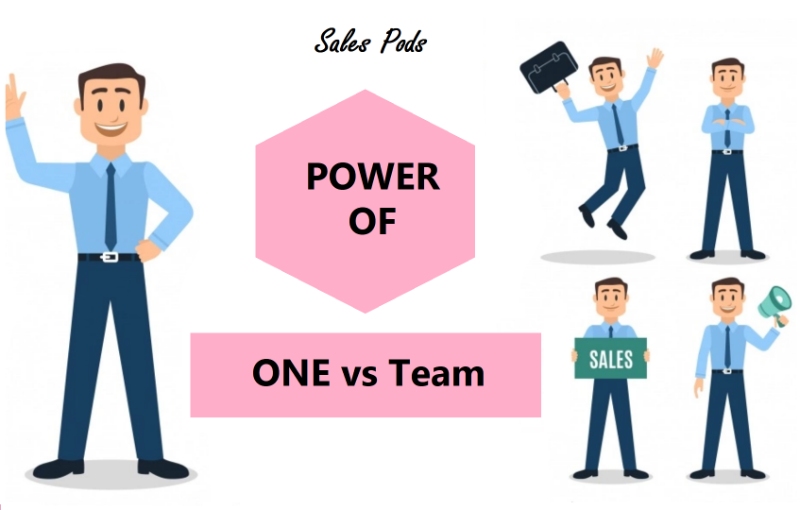
The key principle behind the sales pod structure is to create a cohesive and highly collaborative environment where team members can support and motivate each other, share best practices, and collectively strive for success. By aligning their efforts and leveraging each other's strengths, sales pods can enhance efficiency, improve communication, and increase the overall effectiveness of the sales team.
For example, in a typical sales pod, an SDR could focus on sales prospecting, an AE could work on client acquisition, while a CSM would be responsible for onboarding new customers and ensuring a seamless workflow between them and the team.
This way, each member of the pod can contribute to their specific domain in the sales cycle. This ensures unsurpassed quality control from start to finish.
Importance and Benefits of Implementing Sales Pods
Enhanced Collaboration
Sales pods foster a culture of collaboration by bringing together individuals with diverse skills and expertise. This promotes knowledge sharing, idea generation, and problem-solving, leading to better outcomes. Additionally, implementing Kanban for multiple projects within can enhance workflow management even more and ensure that tasks are efficiently prioritized and completed.
Increased Accountability
With sales pods, team members hold each other accountable for their individual and collective performance. This shared responsibility creates a sense of ownership and motivation to achieve sales targets.
Streamlined Communication
Sales pods facilitate seamless communication among team members, enabling quick and effective information sharing. This ensures that everyone is aligned and informed about important updates, customer insights, and sales strategies.
Scalability
As an organization grows, multiple sales pods can be deployed while keeping the size of a pod roughly the same. This makes sales pods a horizontally scalable sales model, as the best way to scale the model is to increase the number of new sales pods within a sales organization, not the number of salespersons within a pod.
Vertical scaling goes against the philosophy behind this structure in the first place, which encourages small but skilled and efficient teams.
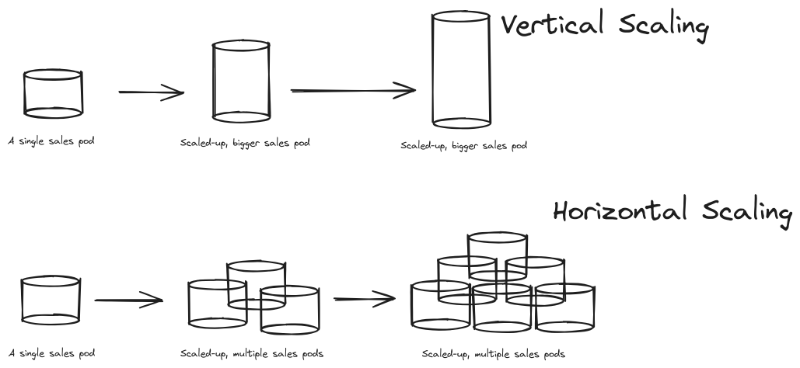
Improved Efficiency
Multiple pods working together can eliminate redundant tasks, streamline processes, and optimize workflow. This results in improved efficiency and productivity within the sales team. This can be especially beneficial if you're running a wholesale B2B marketplace as it allows you to manage and coordinate a large number of transactions and interactions with various buyers and sellers.
Adaptability and Flexibility
Sales pods are designed to be agile and adaptable, allowing teams to respond swiftly to changing market dynamics, customer needs, and sales opportunities. The way one company structures its sales pod strategy could be extremely different than another. This flexibility enables them to stay ahead of the competition and seize growth opportunities.
Skill Development and Learning
In a sales pod structure, team members have the opportunity to learn from each other's experiences, share best practices, and develop new skills. This continuous learning environment enhances individual and team growth, leading to improved performance.
Enhanced Customer Focus
Sales pods enable a customer-centric approach by ensuring that each customer receives personalized attention and support. Team members can collaborate to provide comprehensive solutions and build strong customer relationships. Sales engineers, customer success teams, AEs, and CSMs work together as one part of the sales pod towards the crucial goal of providing the best customer experience.
Sales Pod Structure
A sales pod typically follows a structured framework that encourages collaboration, accountability, and seamless coordination among team members.
While the specific sales pod structure may vary based on the organization's needs and sales process, the following elements are commonly found in a sales pod:
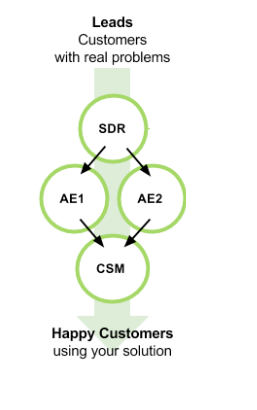
Pod Size
A sales pod consists of a small group of sales representatives, typically ranging from 3 to 8 members. This size allows for effective communication and close collaboration among team members.
Pod Leader
Each sales pod has a designated leader who oversees the pod's activities and serves as a point of contact for team members. The pod leader is responsible for guiding the pod's sales strategy, setting goals, and ensuring the team's success.
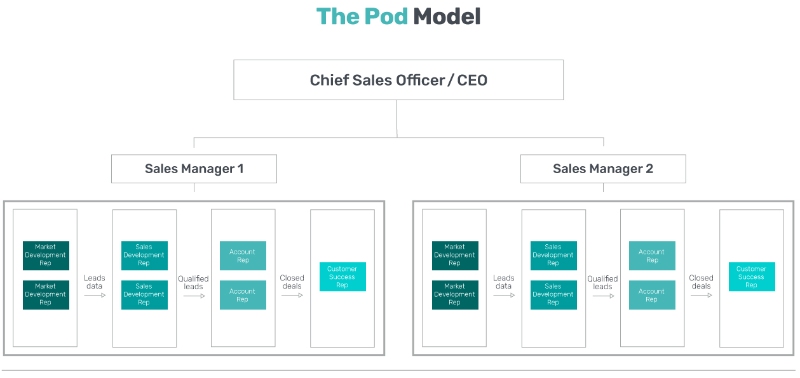
Specialized Roles
Within the sales pod, different team members may have specialized, specific roles based on their skills, expertise, or assigned territories. This ensures that each member brings unique strengths to the pod and contributes to its overall success.
Clear Goals and Metrics
The sales pod operates with a set of clear goals and key performance indicators (KPIs) that align with the organization's sales objectives. These goals may include revenue targets, conversion rates, customer acquisition, or other relevant metrics.
Regular Meetings
Sales pods hold regular meetings to discuss progress, share updates, and align strategies. These meetings can include daily huddles for quick check-ins, weekly or bi-weekly planning sessions, and monthly performance reviews.

Collaborative Tools
This may include free project management software, CRM systems, communication platforms, and other digital tools that enable seamless collaboration. Sales pods utilize collaborative tools and technologies to facilitate communication, document sharing, and real-time updates. This may include project management software, CRM systems, communication platforms, and other digital tools that enable seamless collaboration. If the process involves developing a product sales teams can also leverage enterprise product management software to manage the entire product lifecycle, from ideation to launch and beyond, ensuring alignment between product development and sales efforts.

Knowledge Sharing and Training
Sales pods encourage knowledge sharing among team members, where best practices, sales techniques, and market insights are shared. Regular training sessions and skill-building activities may also be conducted to enhance the expertise of the entire pod. Companies can even partner with elearning video production companies to create education videos that can be tailored to the specific needs of each pod.
Performance Tracking and Accountability
In a sales pod structure, individual and collective performance is tracked and measured. Team members are accountable for their results and collaborate to identify areas of improvement and develop strategies to overcome challenges. For teams looking to map out sales processes and establish clear, strategic goals, utilizing logic model templates by Miro can help visualize each stage of collaboration and performance tracking within a sales pod structure. Using a reliable time monitoring app can be useful in this structure to track how much time is spent on various tasks, helping the team optimize their workflows and improve overall efficiency.
Tools and Technologies
Sales pods can benefit greatly from utilizing various tools and technologies to enhance their efficiency, collaboration, and overall performance. Here are some essential tools and technologies that can support sales pods.
CRM Software
A robust Customer Relationship Management (CRM) software serves as the central hub for managing customer information, tracking sales activities, and monitoring the sales pipeline. It enables sales teams to have a unified view of customer interactions, facilitates lead management, and helps prioritize sales efforts.
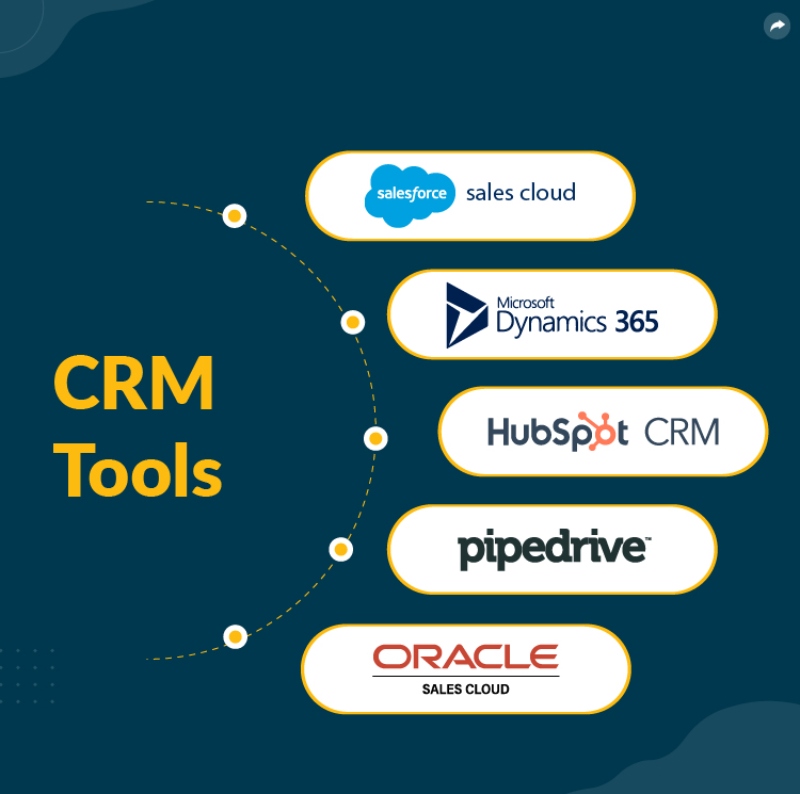
Communication and Collaboration Tools
Effective communication is crucial for sales pods. Tools like Slack, Microsoft Teams, or other team collaboration platforms allow team members to communicate in real-time, share updates, collaborate on projects, and coordinate tasks efficiently. Video conferencing tools such as Zoom or Google Meet enable virtual meetings and face-to-face interactions. During these meetings, using an AI note taker for Google Meet can help automatically capture key points and action items, so the team can stay fully focused on the discussion without worrying about missing important details. Tools are also offered as a software-as-a-service. These SaaS sales tools offer their products or services in a pay-as-you-go model, a popular choice for businesses these days.

Sales Engagement Platforms
Sales engagement platforms like Outreach, SalesLoft, or HubSpot Sales Hub provide automation and personalization features to streamline sales activities. These tools can assist in managing email campaigns, tracking customer interactions, scheduling follow-ups, and analyzing engagement metrics.

Performance Tracking and Analytics Tools
Sales pods can leverage analytics tools like Salesforce Analytics, Tableau, or Power BI to monitor key sales metrics, track individual and team performance, and gain insights into sales trends. These tools enable data-driven decision-making and help identify areas for improvement.
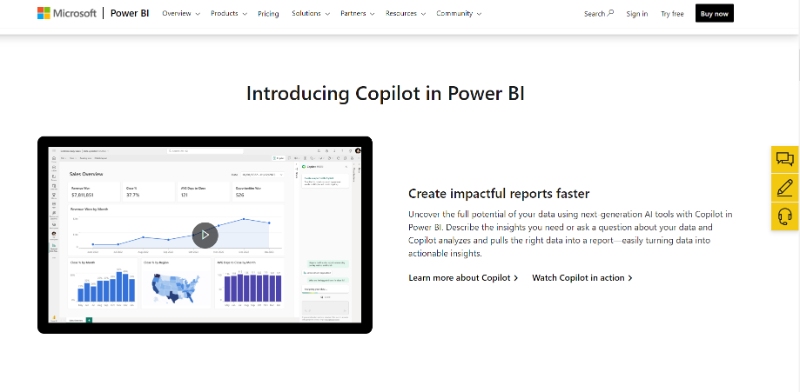
Document and Content Management Systems
Sales pods often collaborate on creating and sharing sales collateral, proposals, presentations, and other documents. Document management systems like Google Drive, SharePoint, or Dropbox provide a centralized repository for storing, organizing, and sharing sales-related content.
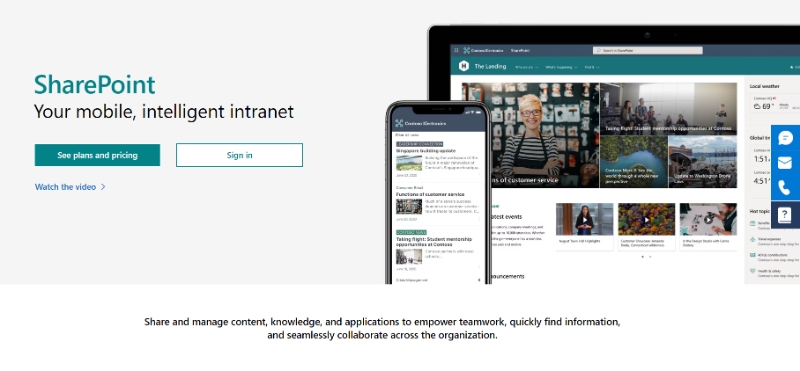
Sales Enablement Platforms
Sales enablement platforms such as Highspot, Showpad, or Seismic can help sales teams access relevant content, training materials, and sales playbooks. These platforms ensure that sales reps have the necessary resources and information at their fingertips to engage with prospects effectively.
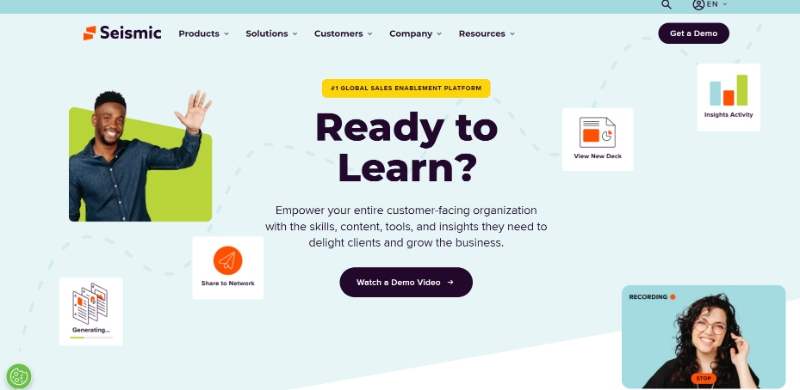
Social Selling Tools
Social media plays a vital role in modern sales. Social selling tools like LinkedIn Sales Navigator, Hootsuite, or Sprout Social enable sales reps to identify and engage with prospects on social platforms, build relationships, and share relevant content to nurture leads. If you don't have social media accounts yet, brainstorm username ideas, pick one that best represents your brand, and start posting and developing your accounts.
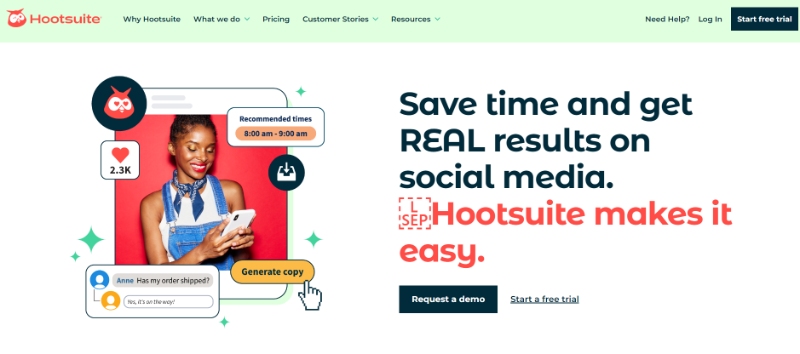
To Build an Effective Sales Pod
Building an effective sales pod structure requires careful planning and consideration of various factors. Here are some essentials to keep in mind:
- Clearly outline each team member's responsibilities and ensure they align with the overall sales goals.
- Foster collaboration between different roles within the sales pod to leverage the collective expertise of the team.
- Establish clear and measurable goals for the sales pod as a whole and for individual team members. Align these goals with the broader sales objectives of the organization.
- Regularly track and evaluate progress towards these goals.
- Implement effective communication channels within the sales pod.
- Develop standardized processes and workflows for lead management, qualification, and handover between team members.
- Clearly document these processes and ensure they are followed consistently to maintain efficiency and clarity.
- Provide ongoing training and professional development opportunities for sales pod members to keep their skills and knowledge up to date.
- Implement systems to track and measure the performance of the sales pod and individual team members.
- Foster a culture of feedback and recognition within the sales pod. Provide constructive feedback.
- Sales pod structures should be flexible and adaptable to changing market conditions.
By incorporating these essentials into the sales pod structure, organizations can create a collaborative, goal-oriented, and high-performing sales team that drives success and achieves desired sales outcomes.
Sales Pod – LinkedIn Success Story
Background
LinkedIn, the world's largest professional networking platform, utilizes a sales pod structure called the "Enterprise Relationship Model (ERM). LinkedIn is a vast professional network with over 700 million users worldwide, and it saw an opportunity to leverage this huge user base for B2B sales. In 2014, it launched Sales Navigator, a specialized product designed to help sales professionals tap into LinkedIn's network more effectively. LinkedIn's Sales Navigator is a practical and successful embodiment of the Sales Pod model.

Reasons for Success
Sales Navigator's success can be attributed to a number of factors that align with the principles of this sales model:
Leveraging Specialization
Each member of the sales pod focuses on their area of expertise, ensuring high performance and efficiency. This specialization allows for more targeted strategies and helps to provide a personalized experience to the customer, thus increasing satisfaction and loyalty.
Collaboration and Communication
Sales Navigator encourages and facilitates collaboration within the sales pod. Everyone can see the interactions with the lead, reducing the risk of miscommunication or duplicated efforts.
Data-driven decision making
Sales Navigator provides advanced analytics to track performance and understand the effectiveness of sales efforts. Its built-in advanced search filters also play a key role in enabling precise lead targeting, helping teams identify high-potential prospects more efficiently. This allows the team to refine their strategy based on data rather than guesses. An AI sales tool further enhances this by providing predictive analytics, helping pods stay ahead in a competitive environment. By fine-tuning their models, teams can extract deeper insights and optimize their performance even more.
Scalability
As a digital platform, Sales Navigator can easily scale with the business. Multiple pods can be created as the business grows, allowing for effective management of an expanding client base.
The success of LinkedIn's Sales Navigator can be attributed to the effective use of the Sales Pod model, leveraging specialization, fostering collaboration, using data-driven decision-making, and providing scalability. As such, it serves as a compelling case study for the benefits of the Sales Pod model in sales strategy.
Conclusion
In summary, sales pods represent a shift from traditional sales team structures, promoting collaboration and shared accountability. By organizing sales professionals into small, cross-functional teams, businesses can unlock the potential for improved performance, enhanced customer relationships, and, ultimately, better sales outcomes.
Ultimately, needs vary from business to business, and the right sales model for you is the one that fits your particular use case.


